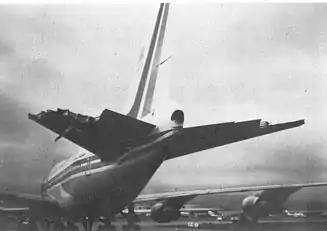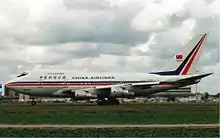China Airlines Flight 006
China Airlines Flight 006 (callsign "Dynasty 006") was a daily non-stop flight from Taipei to Los Angeles International Airport. On 19 February 1985, the Boeing 747SP operating the flight was involved in an aircraft upset accident, following the failure of the No. 4 engine, while cruising at 41,000 ft (12,500 m). The plane rolled over and plunged 30,000 ft (9,100 m), experiencing high speeds and g-forces (approaching and, at one point, exceeding 5g) before the captain was able to recover from the dive, and then to divert to San Francisco International Airport.[1]
 Damage to N4522V's horizontal stabilizers after it experienced a free fall of 30,000 ft | |
| Accident | |
|---|---|
| Date | 19 February 1985 |
| Summary | High altitude upset and 30,000 ft. dive due to spatial disorientation after failure of Engine 4 |
| Site | Pacific Ocean, near San Francisco, California, United States |
| Aircraft | |
| Aircraft type | Boeing 747SP-09 |
| Operator | China Airlines |
| Registration | N4522V |
| Flight origin | Chiang Kai Shek Int'l Airport |
| Destination | Los Angeles Int'l Airport |
| Occupants | 274 |
| Passengers | 251 |
| Crew | 23 |
| Fatalities | 0 |
| Injuries | 24 (2 serious) |
| Survivors | 274 |
Accident

The aircraft had departed from Taipei at 16:22 local time. The accident occurred 10 hours into the flight. The Boeing 747SP-09 was 350 miles (560 km) northwest of San Francisco, cruising at an altitude of 41,000 ft (12,500 m). The cockpit crew consisted of Captain Min-Yuan Ho, age 55, First Officer Ju-Yue Chang, age 53, Flight Engineer Kuo-Pin Wei, age 55, Relief Captain Chien-Yuan Liao, age 53, and Relief Flight Engineer Shih-Lung Su, age 41.[1] Captain Ho had approximately 15,500 flight hours, including 3,748 hours on the Boeing 747. The First Officer had more than 7,700 hours with 4,553 of them on the Boeing 747, and the Flight Engineer had approximately 15,500 hours of flight time, including 4,363 hours on the Boeing 747.[1] The accident occurred while the main crew was on duty.
The sequence began with a loss of thrust in the No. 4 Engine. That engine had failed twice during previous flights (while cruising at FL 410 and 430). In each of those cases, the engine was restarted after descending to a lower altitude. The maintenance response to the logbook entries that noted the problems included engine inspection, fuel filter drainage and replacement, vane controller inspection and replacement, water drainage from Mach probes, and other filter replacements. None of those acts fixed the recurrent problem of the No. 4 engine.[1][2]

The flight engineer attempted to restore power to the engine, but didn't close the bleed valve, as required by the checklist procedure.[1]:26 After the flight engineer announced the engine had flamed out, the captain instructed him to restart it, and ordered the first officer to request clearance for a descent from FL 410 (41,000 feet). According to the flight manual, engine restart is unlikely to succeed above 30,000 feet (9,100 m). The attempt failed.[1]:2
Meanwhile, airspeed continued to decrease, and the autopilot rolled the control wheel to the maximum left limit of 23 degrees. As the speed decreased even further, the plane began to roll to the right, even though the autopilot was maintaining the maximum left roll limit. By the time the captain disconnected the autopilot, the plane had rolled over 60 degrees to the right and the nose had begun to drop. Ailerons and flight spoilers were the only means available to the autopilot to keep the wings level as the autopilot does not connect to the rudder during normal flight. To counteract the asymmetrical forces created by the loss of thrust from the No. 4 engine, it was essential for the pilot to manually push on the left rudder. However, the captain failed to use any rudder inputs at all, before or after disconnecting the autopilot. The resulting uncontrolled flight path is depicted in the diagram.[1]:10–11
As the plane descended through clouds, the captain's attention was drawn to the attitude indicator which displayed excessive bank and pitch. Because such an attitude is highly irregular, the captain incorrectly assumed the indicators to be faulty.[1]:3 Without any visual references (due to the clouds) and having rejected the information from the attitude indicators, the captain and first officer became spatially disoriented.[1]:31
Only after breaking through the bottom of the clouds at 11,000 feet (3,400 m) was the captain able to orient himself and bring the plane under control, leveling out at 9,600 feet (2,900 m). They had descended 30,000 ft (9,100 m) in under two and a half minutes while all onboard experienced g-forces as high as 5g.[1]:12 The cockpit crew believed that all four engines had flamed out, but the National Transportation Safety Board found that only engine No. 4 had failed.
After leveling out, the three remaining engines were supplying normal thrust. A restart attempt brought No. 4 back into use. They began climbing and reported to air traffic control "condition normal now" and continuing on to Los Angeles. They then noticed that the inboard main landing gear was down and one of the plane's hydraulic systems was empty.[1]:5 Because they did not have sufficient fuel to reach Los Angeles with the drag added by the landing gear, they diverted to San Francisco. An emergency was then declared and they flew straight into San Francisco airport.[1]:5 The plane landed without further incident.[3]
Aftermath

There were two serious injuries on board: a fracture and laceration of a foot, and an acute back strain requiring two days of hospitalization. The aircraft was significantly damaged by the excessive G-forces. The wings were permanently bent upwards by 2 inches (5 cm), the inboard main landing gear lost two actuator doors, and the two inboard main gear struts were left dangling.[1][4] Most affected was the tail, where large outer parts of the horizontal stabilizer had been ripped off. The entire left outboard elevator had been lost along with its actuator, which had been powered by the hydraulic system that ruptured and drained.[1][4]
After repairs were made to the plane, it returned to service on 25 April 1985. It continued in service for nearly 12 years until it was leased to China Airlines' sister company, Mandarin Airlines, on 1 January 1997, and was in daily service for the remainder of that year.[5] Mandarin then sent it to McCarran International Airport for storage. From April 2002 it was owned and operated by a religious organization known as Gospel to the Unreached Millions (GUM), headed by K. A. Paul, and was christened 'Global Peace One'. On 17 July 2005, the FAA suspended its operating certificate due to insufficient maintenance. As of 20 May 2010, the aircraft was kept in a large hangar at General Abelardo L. Rodríguez International Airport in Tijuana, Baja California, and reported to be in very poor condition.
In its final report, the US NTSB stated "The Safety Board can only conclude that the captain was distracted first by the evaluation of the engine malfunction and second by his attempts to arrest the decreasing airspeed, and that, because of these distractions, he was unable to assess properly and promptly the approaching loss of airplane control. The Safety Board also concludes that the captain over-relied on the autopilot and that this was also causal to the accident since the autopilot effectively masked the approaching onset of the loss of control of the airplane."[1]
China Airlines still operates one of its scheduled Taipei-Los Angeles services as Dynasty 006, utilizing the Boeing 747-400 until late 2014, when the Boeing 777-300ER replaced it.[6]
In popular culture
- The Discovery Channel Canada / National Geographic TV series Mayday (also called Air Crash Investigation or Air Emergency) dramatized the accident in a 2007 episode titled Panic Over the Pacific.[7]
- The flight was documented on an episode of the Weather Channel television program Why Planes Crash titled "Who's Flying".
See also
- TAROM Flight 371, another incident involving asymmetric thrust
References
- "Aircraft accident report : China Airlines Boeing 747-SP, N4522V, 300 nautical miles northwest of San Francisco, California, February 19, 1985" (PDF). National Transportation Safety Board. 29 March 1986. NTSB/AAR-86/03. Retrieved 30 April 2019.
- "Production List". Boeing 747SP Website. Archived from the original on 4 June 2012. Retrieved 9 February 2015.
- Flying Magazine. October 1986.
- NTSB Archived 17 December 2005 at the Wayback Machine report courtesy of University of Bielefeld – Faculty of technology html version by Hiroshi Sogame Safety Promotion Comt. All Nippon Airways
- "N4522V Global Peace Ambassadors Boeing 747SP". www.planespotters.net. Retrieved 24 December 2020.
- "China Airlines (CI) #6 ✈ FlightAware". FlightAware. Retrieved 19 June 2016.
- "Panic Over the Pacific". Mayday. Season 4. 2007. Discovery Channel Canada / National Geographic Channel.
External links
- Accident Brief by the U.S. National Transportation Safety Board.
- Full Accident Report by the U.S. National Transportation Safety Board.
- (Alternate (Archived 17 December 2005 at the Wayback Machine) report courtesy of University of Bielefeld – Faculty of technology html version by Hiroshi Sogame Safety Promotion Comt. All Nippon Airways)
- Summary and comments in Risks Digest.
- Time Magazine story
- German article with pictures of the damaged airplane after landing in Der Spiegel